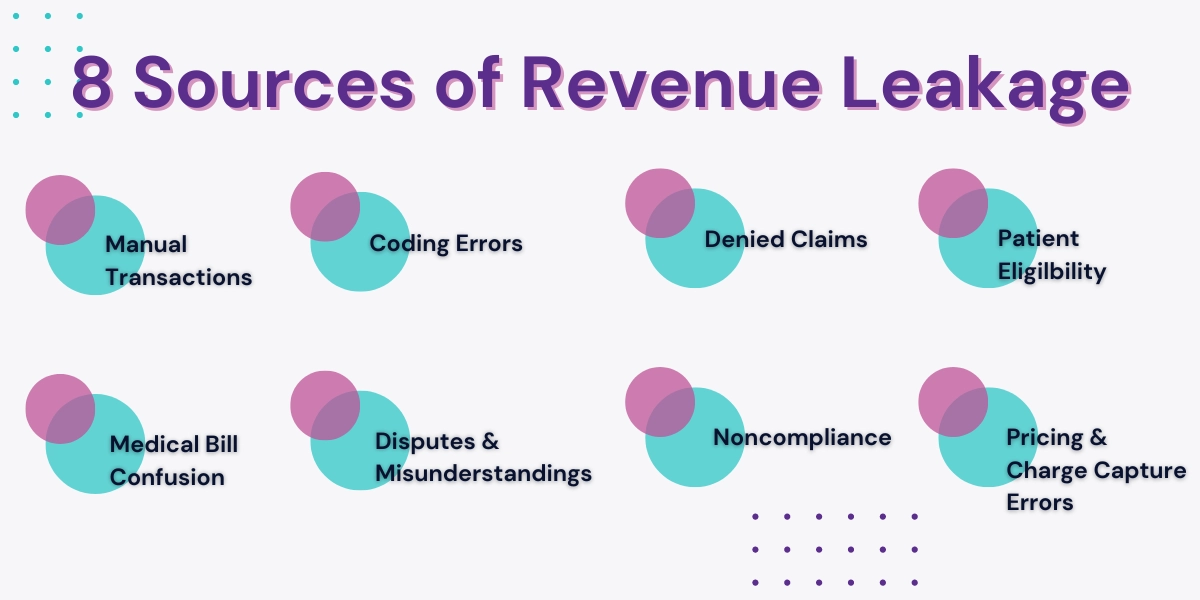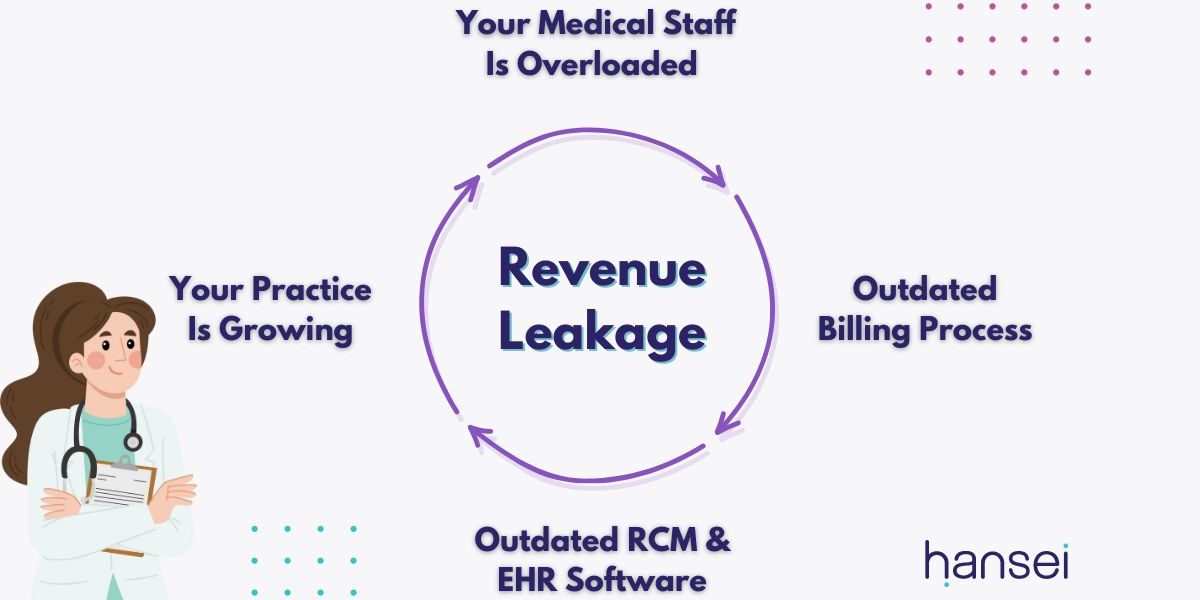Blog

Table of Contents
In today’s healthcare market, with rising medical costs, expanded insurance coverage, and pandemics, medical practices can’t afford revenue leakage. Unfortunately, one report states that more than 40% of healthcare organizations lose 10% or more of annual revenues, 19% lose more than 20% to revenue leakage, and 23% don’t know how much they’re losing.
This article is meant to help healthcare providers understand revenue leakage, including why it happens and how to prevent it.
What Is Revenue Leakage?
Revenue leakage is when a healthcare provider provides care and services to a patient but does not receive payment. This usually happens because the medical bills (accounts receivable) are sent after the services are rendered and can go unpaid for long periods of time, resulting in revenue loss. When the accounts receivable (AR) cycle goes beyond 120 days, healthcare providers can only expect to receive only ten cents for every dollar owed. Solving revenue leakage isn’t as simple as implementing a single solution because it can be caused by various factors, including providers’ processes, patients, or payors.
Revenue Leakage Across The U.S.
Since the beginning of the pandemic, private physicians in the United States experienced an estimated loss of $158.35 billion in revenue. This could be linked to COVID-19 since patients were avoiding public places and businesses (especially doctor’s offices in case someone was sick). When patients resumed regular doctor visits, the time between care could have worsened their conditions or allowed them to go unnoticed. This resulted in higher healthcare costs once they eventually noticed the need for treatment.

8 Sources of Revenue Leakage for Healthcare Providers
Revenue leakage usually results because of poor revenue cycle management. Meaning you’re not following up on outstanding claims, appealing denied claims, or ensuring the functionality of your medical billing process.
- Manual transactions: It’s easy to understand that manual transactions between healthcare providers and payers cost more than electronic transactions, but the actual numbers are surprising. Let’s take a look: if you’re still manually checking the status of a claim, you end up paying an extra $7.94 for each claim and an additional $5.72 for every remittance advice (explanation from a health plan to a provider about a claim payment).
- Coding errors: The main reason why complex claims are denied by healthcare organizations like Medicare and Medicaid is due to coding errors. It’s like a double-edged sword because gaps in Diagnosis Related Group (DRG) coding not only affect the reporting of quality metrics but also the level of care provided, which can ultimately impact reimbursement.
- Denied claims: Based on a 2020 Change Healthcare Revenue Cycle Index report, approximately 11.1% of claims were denied upon submission. On average, healthcare providers spend around $25 and up to 33 minutes to investigate, manually process and appeal each denied claim. However, there’s good news: 90% of denials can be prevented, and 67% are eligible for appeal.
- Patient eligibility: The leading cause of claim denials and revenue leakage is when a patient’s eligibility isn’t verified and uncovered services are rendered. By confirming patient insurance eligibility upfront, you can save money on collection costs and improve your chances of receiving the full payment you are owed.
- Medical bill confusion: Understanding a complicated medical bill can be challenging for patients not used to specific treatment services. In fact, 75% of healthcare providers’ unpaid debts result from unanswered billing questions. This places the responsibility on providers to offer clear cost estimates, make billing statements easier to understand, and provide financial options to facilitate payment.
- Disputes and misunderstandings: Insurance companies have varying policies, and what might have been acceptable with one payer may not be applicable to the new one. Miscommunication errors can also result in underpayments when patients switch coverage from one insurance provider to another. While underpaid claims are better than completely denied claims, they still negatively impact your healthcare organization’s financial performance.
- Noncompliance: Failure to comply with industry regulations and standards can have serious consequences for your healthcare organization, including legal and financial penalties like fines and reduced reimbursements. Noncompliance can also harm the organization’s reputation, causing patients to leave and contracts with insurance companies and other partners to expire without renewals or favorable renegotiations.
- Pricing and charge capture errors: Errors in pricing and charge capture can have a major impact on the financial stability of your practice. Undercharging may result in incomplete payment for services rendered while overcharging can lead to trust issues with patients and damage the organization’s reputation. Moreover, there may be legal implications, such as civil penalties, associated with overcharging.
How To Prevent Revenue Leakage At Your Practice
- Utilize a revenue cycle management (RCM) system: Revenue cycle management (RCM) is the process of tracking a patient’s payments from their first interaction with your practice until they settle their final balance. Managing this process manually can be difficult, but RCM software can automate and streamline tasks like verifying insurance coverage, generating patient bills, managing the submission and resolution of insurance claims, and tracking and reporting payments received.
- Conduct regular audits and monitoring: It’s important to conduct regular audits of your coding, documentation, and data entry practices. A lot of mistakes can go unnoticed without proper monitoring and auditing systems in place. A thorough audit helps identify and correct errors before they impact your finances, leading to better revenue cycle management. Create a checklist for the revenue leakage audit to identify areas prone to errors, such as charge capture, documentation, compliance, or insurance claims.
- Educate your staff on proper practices: Documentation errors, such as missing data and invalid codes, frequently occur due to human mistakes. It is important to provide proper training to your staff on coding and billing processes, even if you plan to automate most of these tasks. This training helps your employees stay informed about current issues and know how to prevent mistakes on their end.
- Negotiate better contracts with payors: During contract negotiations, both parties seek to secure the most advantageous terms possible. Your practice aims to negotiate fair reimbursement rates that adequately cover the cost of providing care while allowing for sustainable revenue generation. On the other hand, insurance payors seek to manage costs and ensure value for their members or beneficiaries. To support your negotiations and increase the likelihood of securing favorable contracts, talk to an RCM specialist who can analyze your practice and demonstrate your ability to deliver quality care, and prove the value of your practice to payors.
- Streamline how patients pay bills: Patients want to know how much they will pay before they receive healthcare services since their copays don’t reflect the entire cost of treatment. Allow your patients to check and pay medical bills online, and if you send bills through the mail, make sure they reach the recipient and follow up before it goes to collections.
Read more: Simple Steps To Prevent Healthcare & Insurance Claim Denials

Do You Need Professional Revenue Leakage Experts?
(include this graphic, edit if needed)
It can be challenging to juggle the daily ins and outs of your healthcare practice and ensure medical bills are sent out and reimbursed. But before you outsource your medical billing or revenue cycle management process, check if:
- Your staff is overloaded: Your healthcare staff is trained to handle the billing process, including inputting medical codes, following up on claims, and utilization review. If your staff is overloaded and behind on the medical billing side of your practice, it’s time to hire a dedicated team to address any causes of revenue leakage.
- Your processes and software are outdated: If your practice uses outdated EHR or billing systems, chances are your staff is struggling with inefficient or lagging software. Revenue cycle management teams like Hansei Solutions can introduce you to EHR programs that utilize AI and automated billing processes, improving your staff’s workflow.
- Your growing quicker than expected: If your practice is growing, but you’re not improving your medical billing process, your office can slowly fall behind, affecting your entire bottom line. You could hire additional staff to focus on RCM, but it can take months to find, train, and build a competent billing team, costing you more revenue as problems remain unresolved.
Read more: 14 Important Questions To Ask Your Medical Billing Company
Contact Hansei Solutions
Revenue leakage shouldn’t stop your practice from providing essential healthcare services. As technology and the healthcare industry changes, it’s important to partner with RCM professionals who understand billing, medical coding, denial management, and patient revenue. At Hansei Solutions, we offer comprehensive billing solutions that address even the smallest sources of revenue leakage, ensuring your practice can grow, receive well-deserved reimbursement, and focus on providing the highest levels of patient care.

Ready to focus on providing healthcare? Let us lighten your load.
We’re here to address your pain points and create growth opportunities for your organization. We’re passionate about what we do, and it shows in every interaction. Learn what makes us tick and schedule a demo today.